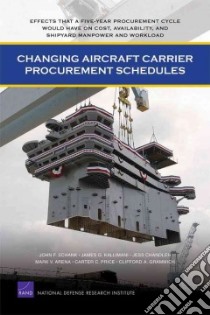Changing Aircraft Carrier Procurement Schedules - 9780833051455
Un libro in lingua di Schank John F. Kallimani James G. Jess Chandler Arena Mark V. Price Carter C. edito da Rand Corp, 2011
- € 25.20
- Il prezzo è variabile in funzione del cambio della valuta d’origine
"Nuclear-powered aircraft carriers are the largest, most capable, and most survivable ships in the U.S. Navy. In the mid-1990s, there were 15 aircraft carriers in the Navy fleet; today, there are 11. The Secretary of Defense recently announced plans to shift the Navy aircraft carrier acquisition program to extend the cycle for acquiring a new aircraft carrier from approximately every four years to five years. In the long run, this could have the effect of reducing the number of aircraft carriers to ten. Shifting from the 30-year shipbuilding plan (SBP) to a five-year authorization cycle for acquiring aircraft carriers should have almost no impact on force structure and the industrial base in the next decade. Beyond the early 2020s, however, the five-yearplan results in an increasingly smaller aircraft carrier force structure and a lower probability of meeting goals for the number of deployed aircraft carriers. The five-year plan will have an impact on the total acquisition costs of CVN 79 and CVN 80 dueto the effects of inflation. The five-year plan could have a larger effect on any subsequent desire to increase the number of aircraft carriers in the fleet. Although the number of aircraft carriers can be rather quickly reduced through early retirements, a construction cycle of at least four years, coupled with seven or more years between authorization and delivery, means that it can take decades to add an aircraft carrier to the fleet. Policymakers might wish to consider this inability to rapidly expand the aircraft carrier force more than any of the factors considered here."--P. [4] of cover.
Informazioni bibliografiche
- Titolo del Libro in lingua: Changing Aircraft Carrier Procurement Schedules
- Sottotitolo: Effects That a Five-Year Procurment Cycle Would Have On Cost, Availability, and Shipyard Manpower and Workload
- Lingua: English
- Autori : Schank John F. Kallimani James G. Jess Chandler Arena Mark V. Price Carter C.
- Editore: Rand Corp
- Collana: Rand Corp (Paperback)
- Data di Pubblicazione: 16 Maggio '11
- Genere: TECHNOLOGY and ENGINEERING
- Argomenti : Aircraft carriers United States Statistics Military planning United States Shipbuilding industry United States
- ISBN-10: 0833051458
- EAN-13: 9780833051455


